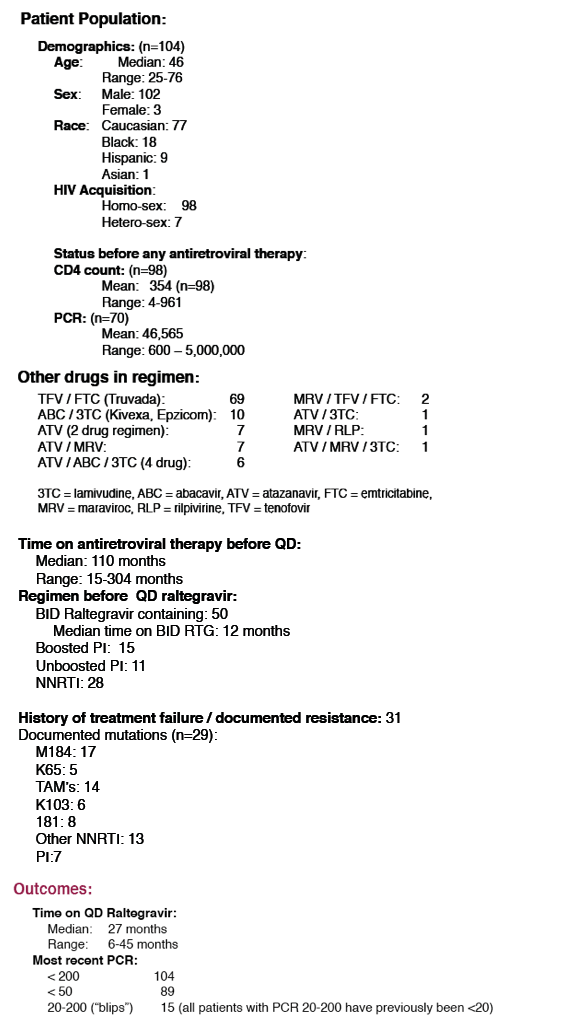| |
Raltegravir 800 mg Once Daily Is Efficacious in Patients Already Virologically Suppressed (Glasgow 2012)
|
| |
| |
Reported by Jules Levin
Glasgow Nov 11-15 2012
Douglas J Ward, MD, Robert R C Grant, BADupont Circle Physicians Group, Washington, DC, USA
Conclusions:
Although this review is small, uncontrolled, and retrospective, it supports the use of raltegravir 800 mg qd in those already on antiretroviral therapy with undetectable viral loads. Although once-daily dosing can not be recommended for those initiating therapy or those with significant antiretroviral resistance, it appears to be sufficient for those already virologically suppressed. For the appropriate patient, once-daily dosing would make raltegravir more convenient, therefore likely increasing adherence and potentially improving outcomes.
Background: Raltegravir (Isentress), the first HIV-1 integrase inhibitor, is a potent and very well tolerated antiretroviral. It is a component of a "preferred" regimen in various treatment guidelines for treatment-naïve patients, and is a common component of salvage regimens. Its only disadvantage is its twice-per-day dosing. Ever since its initial approval there has been interest in once-daily (800 mg) dosing. QD dosing is certainly more convenient, and may improve adherence. The terminal half-life of raltegravir approaches that necessary for once-daily dosing1, and there is some evidence that the intracellular pre-integration complex lasts even longer than the serum half-life2. In early dose-ranging trials, daily doses substantially lower than the recommended 400 mg bid showed efficacy similar to full dose, suggesting that the lower levels at the end of the dosing interval may still have sufficient potency3. In addition, if given with atazanavir, the metabolism of raltegravir by the enzyme UGT A1A is inhibited, resulting in slightly higher drug levels and longer half-life.2 Once daily dosing was investigated in the QDMerck trial4, where raltegravir 800 mg qd was compared to 400 mg bid, given along with tenofovir / emticitabine.
This trial was stopped after 48 weeks because of an increased rate of virologic failure in those on the qd arm, mNY with the development of integrase resistance. Importantly, however, this trial was performed in treatment-naïve patients, and there was a significantly higher risk of virologic failure in those with high baseline PCR (greater than 100,000 c/ml).
This review looks at a different patient population: those already on antiretroviral therapy with undetectable viral loads.
Methods:
This is a retrospective review of patients receiving raltegravir 800 mg qd, along with various other combinations of antiretrovirals, in a large HIV-specialty practice. 104 patients were identified taking raltegravir qd who had at least six months of follow-up after starting daily raltegravir.Two patients stopped treatment while on this regimen; their follow-up time is truncated at the time of discontinuation.

References
1. M Iwamoto, LA Wenning, AS Petry, et al. Safety, Tolerability, and Pharmacokinetics of Raltegravir After Single and Multiple Doses in Healthy Subjects. Clin Pharmacol Ther 2008; 83:293-299
2. Michael Neely, Laurent Decosterd, Aurelir Fayet, et al.Pharmacokinetics and Pharmacogenomics of Once-Daily Raltegravir and Atazanavir in Healthy Volunteers. Antimicrob Agents Chemother. 2010 Nov, 54(11): 4619-2625
3. Markowitz, M et al. Antiretroviral Activity, pharmacokinetics,and tolerability of MK-0518, a novel inhibitor of HIV-1 integrase, dosed as monotherapy in treatment-naive HIV-1-infected individuals. J Acquir. Immune Defic. Syndr.43: 509-515 (2006)
4. 4. JJ Eron, et al. Raltegravir once daily or twice daily in previously untreated patients with HIV-1: a randomized, active-controlled, phase 3 non-inferiority trial. The Lancet Infectious Diseases, 11(12), 907-915, 2011.
| |
| |
| |
|
|
|